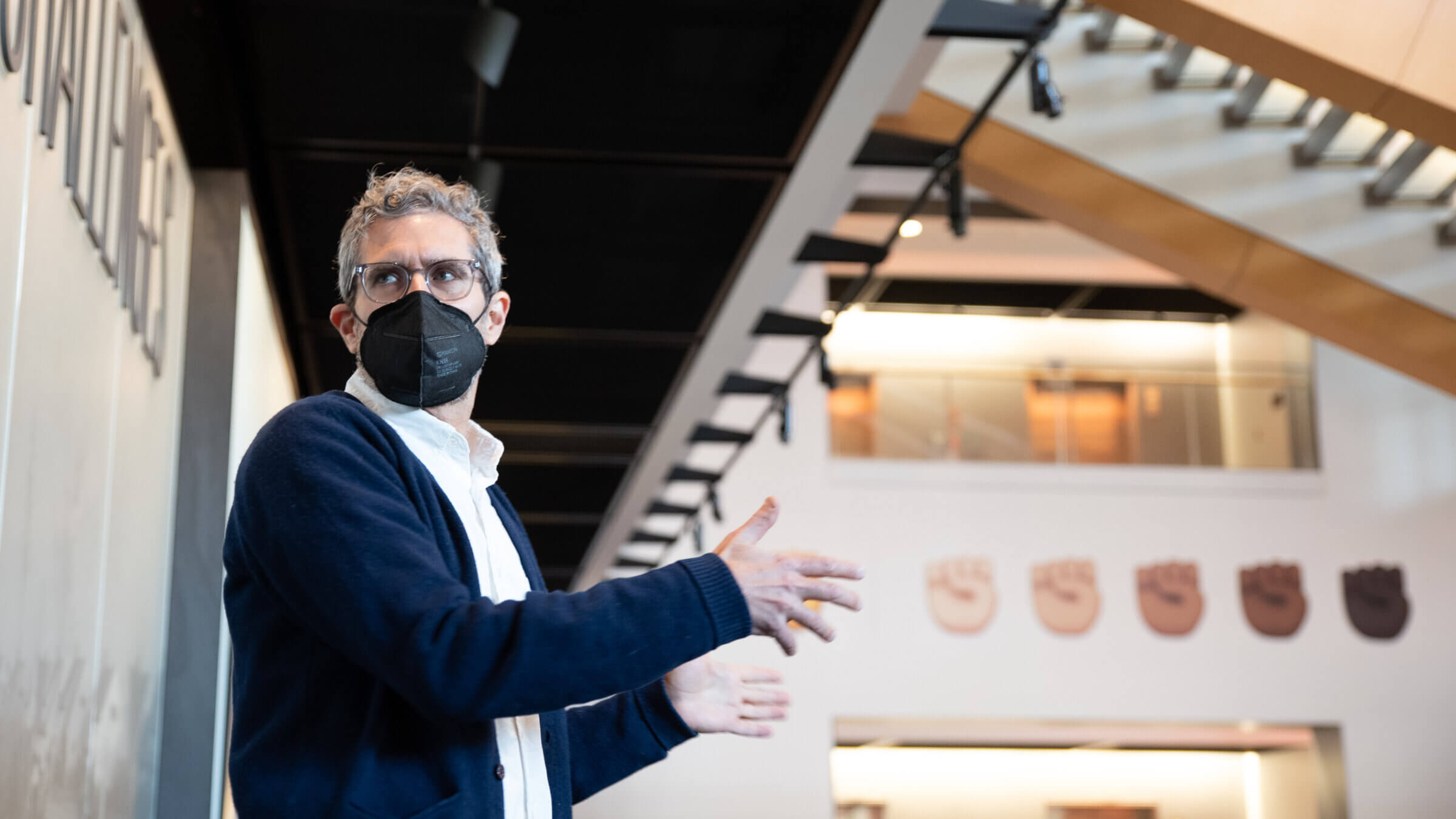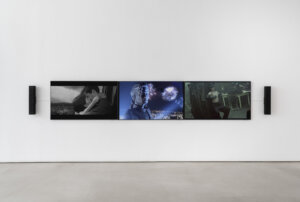His art is chock-full of American pop culture references, so why is it more popular abroad?
Jonathan Horowitz uses icons like Madonna and Michael Jackson to take on authoritarianism and antisemitism

Jonathan Horowitz conducting a tour of The Future Will Follow the Past: An Exhibition by Jonathan Horowitz at The Weitzman National Museum of American Jewish History in Philadelphia.
Artist Jonathan Horowitz, 56, admits that his work is political, but he is no “artivist,” the trendy word referencing an activist artist. “The work is made from a critical perspective, but I’m not trying to position the viewer and elicit any particular response. Even past work that seems like agitprop is really more open.”
Horowitz and I are at the Mitchell-Innes & Nash Gallery on West 26th Street where we are viewing Human Nature, his solo exhibition that illustrates — through video, painting and lenticular photography — human nature in all its permutations. It follows the 2021 Jewish Museum show, We Fight to Build a Free World, which Horowitz curated partly in response to the surge in global anti-antisemitism.
Found footage coupled with pop music, blockbuster films, cult flicks, music videos and other forms of advertising, viewed through the lens of progressive politics are seminal to Horowitz’s vision. “I am a conceptual artist,” he told me.
Human Nature’s centerpiece is a three-channel audio/video installation focusing on representations of the Holocaust and the normalization of authoritarianism, if not fascism. The first screen zeroes in on the 1959 Hollywood movie The Diary of Anne Frank, most pointedly, its promotion of the then-unknown Millie Perkins, former model, soon-to-be starlet. The second monitor highlights the 1995 trailer for Michael Jackson’s HIStory album, in which he appears as a military-style dictator worshipped by throngs of hysterical fans. The third broadcast features scenes from the 1974 soft-core porn cult classic, The Night Porter. Here Nazism is put forward as a sexual fetish. These fragments are interspersed with Madonna sashaying about in skimpy, erotically charged, Nazi-inspired costuming.
Played on a loop, and coupled with a nonstop soundtrack blasting out of three speakers, the montage of noise includes sirens and barking dogs along with the two discrete pop songs, each titled “Human Nature,” one sung by Jackson, the other by Madonna.

“The piece illustrates ways in which capitalism and the entertainment industry utilize and exploit historical atrocity and totalitarian imagery,” Horowitz said. “The story of Anne Frank as it’s told in the 1959 Hollywood movie represents a way of talking about the Holocaust without talking about the Holocaust at all. It’s basically a coming-of-age, teen romance, with Anne’s time at Auschwitz and Bergen-Belsen left out.” The installation includes footage from the movie’s trailer which is quite jarring. There are captions like “’No Greater Suspense Story” and ”The Wonder of Her Youth.”
In addition to the video installation, the exhibit boasts plant paintings and a series of collaborative basket-weave paintings on raw linen made with a group of assistants.
“Each artist is told to paint as well as they can a perfect basket-weave pattern within an approximate space, using only gesso and a single brush,” Horowitz said. “It’s an impossible task to perform perfectly and so each section ends up distorted in different ways. The work is about the acceptance of human limitation.”
A different view of Anne Frank
Perhaps the most memorable piece, short of the installation, is a lenticular photo work, Anne Frank Story, which marries a shot of Anne Frank sitting before a houseplant with the text of her iconic quote, “In spite of everything, I still believe that people are good at heart.”
Imagining what Anne might have felt if she had known what was coming, a new text emerges. Some of the original words have now been crossed off and replaced, to read: “In light of everything I now believe that people are really bad at heart.”
“Lenticular printing is the process of combining two images that change, depending from what angle you’re viewing the picture,” said Horowitz. “From one perspective, there is a wishful expression of hope. When you take a step to the side, the message changes and becomes dark.”
In many ways, this exhibit is an extension of what Horowitz has done in the past, each exhibition exploring cross-cultural themes. For him, antisemitism, for example, cannot be viewed as an isolated event, but rather as another expression of racism and xenophobia.

In Apocalypto Now, a video commissioned by the Ludwig Museum in Germany, and currently on display at the Weitzman National Museum of American Jewish History in Philadelphia, he explores natural catastrophes, real and fictionalized. There is archival footage and film clips, some melodramatic, others campy. There are snippets from Mel Gibson’s The Passion of the Christ and a Diane Sawyer interview with Gibson, a notorious misogynist and antisemite who is waiting for the Rapture. Parody is never far from the surface.
A symbol of pride
Born in New York and raised in Minneapolis, Horowitz came to painting through video. Following his graduation from Wesleyan University with a degree in philosophy, he made his living editing music videos before launching his career in experimental video-making and later moving into sculpture and painting.
His work is held in the collections of numerous museums in London, Paris and South Korea, and in New York at the Museum of Modern Art and the Met. He says he’s had more luck abroad than in the states and is not entirely sure why, especially since so much of his work is rooted in Americana pop culture.
While most of his canon has not focused on Jewish themes and other personal issues, these biographical threads have become more prominent in recent years, coming together in a series of artworks inspired by the work of artists commemorating the Holocaust and displayed at the United States Holocaust Memorial Museum in Washington, D.C.
On a white backdrop, suggested by Ellsworth Kelly’s white wall slabs, Horowitz painted a pink triangle, a badge of shame gay men were forced to wear in Germany during the Nazi regime. Now reclaimed by the LBGTQ+ community as a symbol of honor, Horowitz says the piece pridefully acknowledges his and Kelly’s homosexuality.
Next on his artistic itinerary is an exhibit, World Building, at the The Centre Pompidou-Metz, slated to open June 10 in Lorraine, France. Horowitz will be one of many artists creating and providing “”technologically themed works.” His contribution is a “free tech store,” that will gift to anyone who wants it a range of software and hardware. The economic environmental themes are recycling and alternative forms of exchange.
At the moment, however, his thoughts are focused on Human Nature. In retrospect, he says, he is especially gratified to have had the chance to work with other artists on his collective basket-weave paintings. “I have been working alone mostly for the past three years.”
Human Nature runs at Mitchell-Innes & Nash, 534 W. 26th St., Manhattan, through May 26.






















